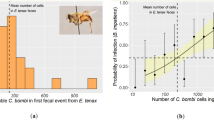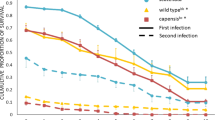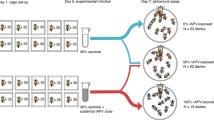These parasites get into bees' nests by fooling males into trying to mate with them.
Abstract
The life cycles of parasites often involve complex behavioural and morphological adaptations in order to find a host. Here we report a remarkable mode of host-finding by the blister beetle Meloe franciscanus, in which young larvae aggregate together on vegetation to mimic the appearance of a female bee, luring male bees to land on them and collect the aggregation as a unit for transmitting to females during real matings. Although cooperative behaviour is common among highly social insects, particularly bees1,2,3, to our knowledge it has not been reported before in blister beetles, nor has it been associated with mimicry.
This is a preview of subscription content, access via your institution
Access options
Subscribe to this journal
Receive 51 print issues and online access
$199.00 per year
only $3.90 per issue
Buy this article
- Purchase on Springer Link
- Instant access to full article PDF
Prices may be subject to local taxes which are calculated during checkout

Similar content being viewed by others
References
Wilson, E. O. The Insect Societies (Harvard Univ. Press, Cambridge, MA, 1971).
Visscher, P. K. & Camazine, S. Nature 397, 400 (1999).
Crespi, B. J. & Choe, J. C. in The Evolution of Social Behavior in Insects and Arachnids (eds Choe, J. C. & Crespi, B. J.) 499–524 (Cambridge Univ. Press, 1997 ).
Cooper, K. W. Trans. Am. Entomol. Soc. 80, 119–174 (1955).
Linnaeus, C. Systema Naturae. Regnum Animale 12th edn (Salvii, Stockholm, 1767).
Pinto, J. D. & Selander, R. B. Ill. Biol. Monogr. 42, 1–222 (1970).
Erickson, E. H. & Werner, F. G. Ann. Entomol. Soc. Am. 67, 903–908 ( 1974).
Clausen, C. P. Annu. Rev. Entomol. 21, 343–368 (1976).
Borg-Karlson, A. K. Phytochemistry 29, 1359–1387 (1990).
von Frisch, K. Bees, their Vision, Chemical Senses, and Language (Cornell Univ. Press, Ithaca, NY, 1950).
Southwood, T. R. E. Ecological Methods (Chapman & Hall, London, 1978 ).
Author information
Authors and Affiliations
Corresponding author
Rights and permissions
About this article
Cite this article
Hafernik, J., Saul-Gershenz, L. Beetle larvae cooperate to mimic bees. Nature 405, 35–36 (2000). https://doi.org/10.1038/35011129
Issue Date:
DOI: https://doi.org/10.1038/35011129
This article is cited by
-
Scotocryptini beetles (Leiodidae) in nests of stingless bees
Apidologie (2023)
-
Signaling without cooperation
Biology & Philosophy (2014)
-
Contrasting needs of grassland dwellers: habitat preferences of endangered steppe beetles (Coleoptera)
Journal of Insect Conservation (2012)
-
Reproductive aspects of Meloetyphlus fuscatus a meloid beetle cleptoparasite of the bee Eulaema nigrita (Hymenoptera, Apidae, Euglossini)
Apidologie (2011)
-
Sex, lies and beetles
Nature (2000)
Comments
By submitting a comment you agree to abide by our Terms and Community Guidelines. If you find something abusive or that does not comply with our terms or guidelines please flag it as inappropriate.



